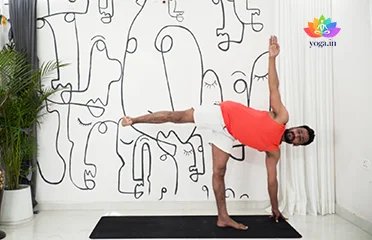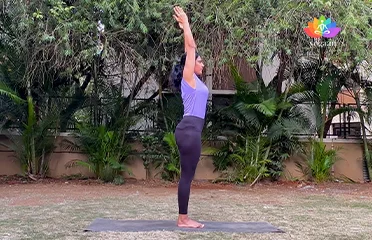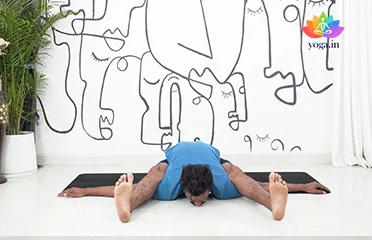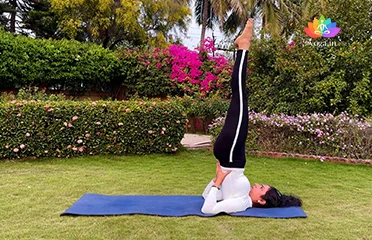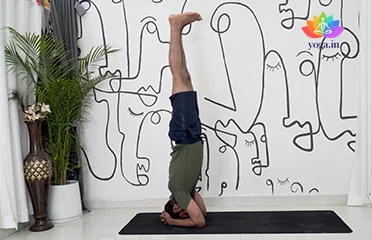Ardha Chandrasana (Half Moon Pose)
अर्धचन्द्रासना / Half Moon Pose
The Sanskrit name is derived from Ardha (अर्ध) meaning half, Chandra [�K]
Hastapadasana (Hand to Foot Pose)
हस्तपदासन / Hand to Foot Pose
The sanskrit name is derived from hasta (हस्त) means hands, pada (पदा) [�K]
Kurmasana (Tortoise Pose)
कूर्मासन / Tortoise Pose
The Sanskrit name is derived from Kurma (कूर्मा) meaning tortoise [�K]
Sarvangasana (Shoulderstand)
सर्वाङ्गासनI / Shoulderstand
The Sanskrit name is derived from Sarva (सर्वाङ्ग) meaning all, [�K]
Sirsasana (Headstand)
शीर्षासन / Headstand
The Sanskrit name is derived from Sirsa (शीर्ष) meaning head and asana [�K]
How Yoga Can Help Cure Cold:
The common cold is a viral infection that affects the upper respiratory tract, causing symptoms like a runny nose, sore throat, and cough. Yoga can help alleviate the symptoms of a cold by boosting the immune system, improving circulation, and promoting relaxation. Through gentle postures, breathing exercises, and meditation, yoga can support the body’s natural healing processes and help you recover more quickly.
Understanding Cold:
A cold is a contagious viral infection that primarily affects the nose and throat. It is usually caused by rhinoviruses and can spread through droplets from coughs and sneezes or through direct contact with contaminated surfaces. While a cold is generally mild and self-limiting, it can cause discomfort and interfere with daily activities.
Yoga’s Role in Relieving Cold:
Specific yoga practices can help relieve the symptoms of a cold by enhancing respiratory function, reducing congestion, and promoting relaxation. Gentle asanas (postures) that open the chest and improve breathing, pranayama (breathing exercises) that clear the nasal passages, and meditation techniques that reduce stress can all contribute to faster recovery.
Key Factors Contributing to Cold:
Several factors can contribute to the development of a cold, including:
- Viral Exposure: Direct contact with cold viruses through airborne droplets or contaminated surfaces.
- Weakened Immune System: Factors like poor diet, lack of sleep, and chronic stress can weaken immunity.
- Seasonal Changes: Colds are more common in fall and winter due to indoor crowding and cold weather.
- Allergies: Allergic reactions can make the nasal passages more susceptible to infections.
- Poor Hygiene: Inadequate handwashing and personal hygiene increase the risk of catching a cold.
Symptoms of Cold:
Common symptoms of a cold include:
- Runny or Stuffy Nose: Excess mucus production leading to nasal congestion.
- Sore Throat: Irritation and scratchiness in the throat.
- Cough: A reflex to clear the throat of mucus or other irritants.
- Sneezing: A sudden, forceful expulsion of air through the nose and mouth.
- Headache: Mild to moderate pain in the head due to congestion.
- Fatigue: Feeling unusually tired and lacking energy.
- Mild Fever: A slight increase in body temperature.
Treatment of Cold through Yoga and Pranayama:
Yoga and pranayama can be very beneficial in managing cold symptoms. Some effective practices include:
Specific Yoga Poses:
- Uttanasana (Standing Forward Bend): Helps clear nasal passages and relieve congestion.
- Setu Bandhasana (Bridge Pose): Opens the chest and improves breathing.
Pranayama Exercises:
- Anulom Vilom (Alternate Nostril Breathing): Clears nasal passages and calms the mind.
- Kapalabhati (Skull Shining Breath): Clears the respiratory tract and increases lung capacity.
Diet for Cold:
A balanced diet can help manage cold symptoms. Recommendations include:
- Hydration: Drink plenty of fluids like water, herbal teas, and clear broths to stay hydrated.
- Vitamin C-Rich Foods: Oranges, strawberries, and bell peppers boost the immune system.
- Warm Soups: Chicken soup and vegetable broth can soothe the throat and provide nutrients.
- Ginger and Honey: Ginger tea with honey can relieve a sore throat and cough.
- Garlic: Known for its antimicrobial properties, garlic can help fight infections.
Caution for Cold:
While practicing yoga for a cold, it is essential to:
- Avoid Overexertion: Practice at a gentle pace to avoid straining the body.
- Be Mindful of Breathing: Stop if any breathing exercises cause discomfort or dizziness.
Contraindications for Cold:
Individuals with severe cold symptoms or respiratory issues should:
- Avoid Intense Yoga Practices: Vigorous exercises might exacerbate symptoms.
- Steer Clear of Certain Poses: Inversions and poses that compress the chest may increase discomfort.
- Seek Professional Guidance: Consult a yoga therapist or healthcare professional for personalized recommendations.


